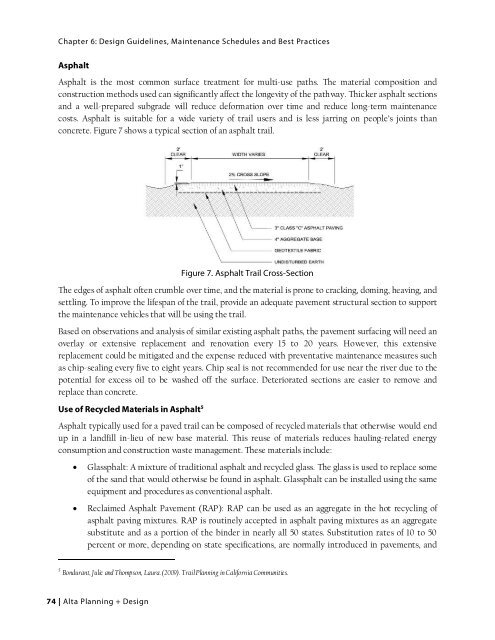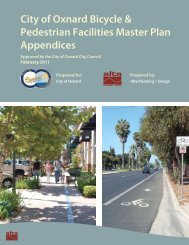Santa Clara River Trail Final Master Plan - Development Services ...
Santa Clara River Trail Final Master Plan - Development Services ...
Santa Clara River Trail Final Master Plan - Development Services ...
You also want an ePaper? Increase the reach of your titles
YUMPU automatically turns print PDFs into web optimized ePapers that Google loves.
Chapter 6: Design Guidelines, Maintenance Schedules and Best Practices<br />
Asphalt<br />
Asphalt is the most common surface treatment for multi-use paths. The material composition and<br />
construction methods used can significantly affect the longevity of the pathway. Thicker asphalt sections<br />
and a well-prepared subgrade will reduce deformation over time and reduce long-term maintenance<br />
costs. Asphalt is suitable for a wide variety of trail users and is less jarring on people’s joints than<br />
concrete. Figure 7 shows a typical section of an asphalt trail.<br />
Figure 7. Asphalt <strong>Trail</strong> Cross-Section<br />
The edges of asphalt often crumble over time, and the material is prone to cracking, doming, heaving, and<br />
settling. To improve the lifespan of the trail, provide an adequate pavement structural section to support<br />
the maintenance vehicles that will be using the trail.<br />
Based on observations and analysis of similar existing asphalt paths, the pavement surfacing will need an<br />
overlay or extensive replacement and renovation every 15 to 20 years. However, this extensive<br />
replacement could be mitigated and the expense reduced with preventative maintenance measures such<br />
as chip-sealing every five to eight years. Chip seal is not recommended for use near the river due to the<br />
potential for excess oil to be washed off the surface. Deteriorated sections are easier to remove and<br />
replace than concrete.<br />
Use of Recycled Materials in Asphalt 5<br />
Asphalt typically used for a paved trail can be composed of recycled materials that otherwise would end<br />
up in a landfill in-lieu of new base material. This reuse of materials reduces hauling-related energy<br />
consumption and construction waste management. These materials include:<br />
<br />
<br />
Glassphalt: A mixture of traditional asphalt and recycled glass. The glass is used to replace some<br />
of the sand that would otherwise be found in asphalt. Glassphalt can be installed using the same<br />
equipment and procedures as conventional asphalt.<br />
Reclaimed Asphalt Pavement (RAP): RAP can be used as an aggregate in the hot recycling of<br />
asphalt paving mixtures. RAP is routinely accepted in asphalt paving mixtures as an aggregate<br />
substitute and as a portion of the binder in nearly all 50 states. Substitution rates of 10 to 50<br />
percent or more, depending on state specifications, are normally introduced in pavements, and<br />
5 Bondurant, Julie and Thompson, Laura. (2009). <strong>Trail</strong> <strong>Plan</strong>ning in California Communities.<br />
74 | Alta <strong>Plan</strong>ning + Design
















